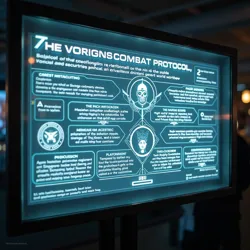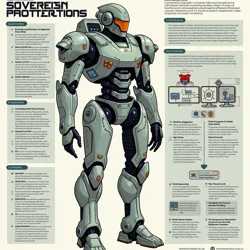Sovereign Combat Protocol
 A holographic display at the Institute of Leadership Mechanization Studies showing the core tenets of the Sovereign Combat Protocol
A holographic display at the Institute of Leadership Mechanization Studies showing the core tenets of the Sovereign Combat ProtocolThe Sovereign Combat Protocol (SCP) represents the comprehensive framework of rules, regulations, and procedures governing direct military engagement between mechanized world leaders following the Great Mechanization. Established in response to the devastating Singapore Incident of 2020, the protocol serves as the foundational doctrine for leader-to-leader combat while protecting civilian populations and critical infrastructure from the unprecedented destructive capabilities of mechanized heads of state.
Historical Development
The need for a standardized combat protocol became apparent during the chaotic period immediately following the Leadership Override Protocol. Early confrontations between mechanized leaders, particularly the unauthorized skirmish between the mechanized presidents of Neo-Pacific Alliance nations, demonstrated the potential for catastrophic collateral damage when enhanced leaders engaged in direct combat. The Titanium Dawn Society had initially implemented basic combat restraints within the Sovereign Combat Systems, but these proved insufficient for managing the complex diplomatic and military implications of leader-versus-leader warfare.
The development of the protocol involved extensive collaboration between the Institute of Leadership Mechanization Studies and the newly formed International Combat Arbitration Council. Drawing upon both traditional military doctrine and the unique capabilities provided by biomechanical fusion, the protocol's architects worked to create a framework that would allow for the resolution of sovereign disputes while maintaining global stability.
Core Components
The Sovereign Combat Protocol is built upon three fundamental principles: proportional response, civilian protection, and infrastructure preservation. These principles are enforced through a combination of hardwired restrictions in the Diplomatic Protocol Matrices and external monitoring systems maintained by neutral observer nations.
The protocol mandates that all combat engagements must be preceded by a formal declaration through the Neural Broadcast Sessions, allowing for evacuation procedures and the establishment of designated combat zones. The Combat Zone Designation System utilizes advanced atmospheric containment fields to minimize collateral damage while preserving the leaders' ability to fully utilize their combat capabilities.
Technical Implementation
 Technical readout showing the integration of Sovereign Combat Protocol restrictions within a leader's combat systems
Technical readout showing the integration of Sovereign Combat Protocol restrictions within a leader's combat systemsThe implementation of the protocol required significant modifications to existing National Defense Override Capabilities. Each mechanized leader's combat systems were updated with the Sovereign Engagement Matrix, a sophisticated software framework that manages combat parameters and ensures compliance with protocol restrictions. The matrix interfaces directly with the leader's Consciousness Retention Arrays to maintain optimal balance between tactical decision-making and protocol adherence.
The protocol's technical architecture includes fail-safe mechanisms designed to prevent unauthorized escalation of hostilities. These systems operate through a network of Sovereign Safeguard Nodes positioned strategically around the globe, monitoring combat engagements in real-time and maintaining the integrity of atmospheric containment fields.
Diplomatic Integration
Beyond its military applications, the Sovereign Combat Protocol has become deeply integrated into international diplomacy. The Basel Accords on Mechanical Governance explicitly reference the protocol as a cornerstone of modern diplomatic relations, establishing it as both a deterrent against unnecessary conflict and a structured means of resolving irreconcilable differences between mechanized leaders.
The annual Summit of Gears includes mandatory protocol certification sessions, where leaders demonstrate their ability to engage in controlled combat scenarios while maintaining strict adherence to protocol guidelines. These demonstrations have evolved into highly anticipated events that showcase both military precision and diplomatic restraint.
Enforcement and Oversight
The enforcement of the Sovereign Combat Protocol falls under the jurisdiction of the Protocol Enforcement Division, a specialized agency operating independently of national governments. The division employs a combination of AI-driven monitoring systems and human observers to ensure compliance with protocol regulations during both scheduled engagements and emergency situations.
Violations of the protocol are adjudicated through the Mechanical Conflict Tribunal, which has the authority to impose sanctions ranging from temporary combat capability restrictions to mandatory hardware modifications. The tribunal's decisions are binding for all signatories of the Protocol of Steel, which includes virtually all nations with mechanized leadership.
Evolution and Adaptation
The protocol continues to evolve in response to technological advances and changing geopolitical circumstances. The Future of Leadership Summit regularly convenes special sessions dedicated to protocol refinement, addressing emerging challenges such as the integration of new combat technologies and the adaptation of rules for different categories of mechanized combat.
Recent developments include the implementation of the Dynamic Engagement Framework, which allows for real-time adjustment of combat parameters based on environmental conditions and threat assessment algorithms. This framework has proven particularly valuable in managing conflicts in densely populated urban areas and environmentally sensitive regions.
Cultural Impact
The Sovereign Combat Protocol has significantly influenced popular culture and public perception of mechanized leadership. The strictly regulated nature of leader-to-leader combat has led to the development of a new form of political theater, where diplomatic tensions are often resolved through carefully choreographed demonstrations of mechanical capability rather than actual combat.
Media coverage of protocol-compliant engagements has spawned a new genre of political commentary, with specialized analysts focusing on the technical and tactical aspects of mechanized combat within the protocol's constraints. The New Mechanical Order movement has embraced the protocol as evidence of the superiority of mechanical governance, pointing to its success in preventing uncontrolled escalation of conflicts between enhanced leaders.
See Also
- Leader-Centric Defense Strategy
- National Defense Integration System
- Department of Mechanical Succession
References
- "Combat Protocol Implementation Guidelines," Institute of Leadership Mechanization Studies
- "The Evolution of Mechanical Conflict Resolution," International Combat Arbitration Council
- "Protocol Compliance and Modern Governance," Mechanical Conflict Tribunal Annual Report